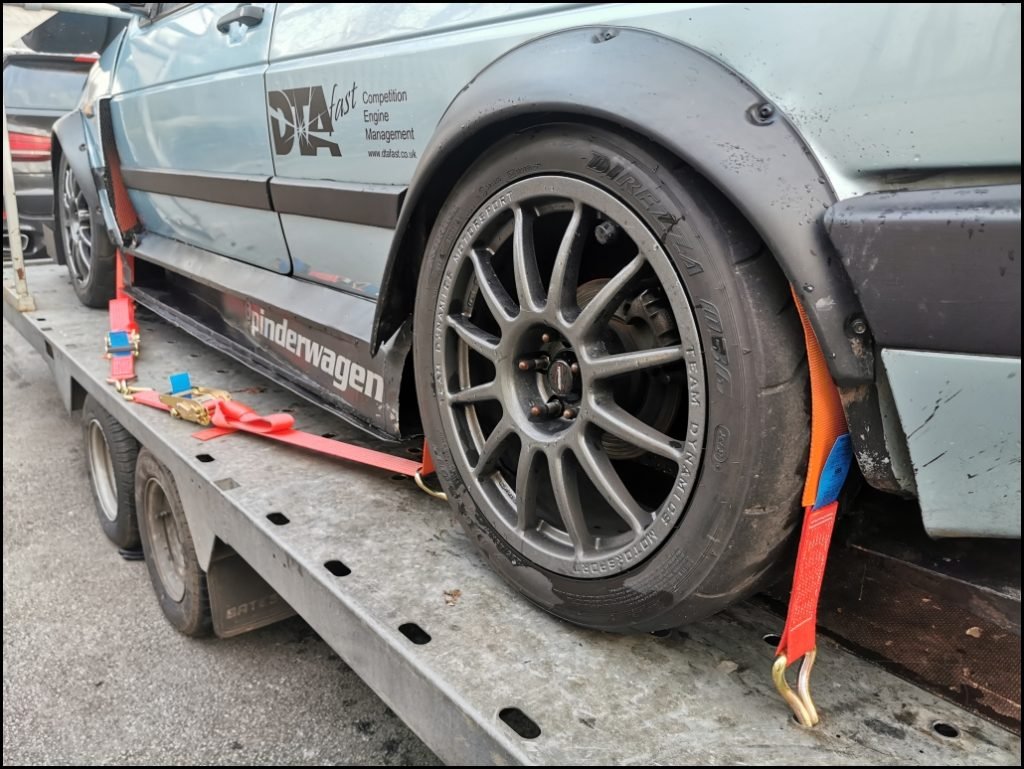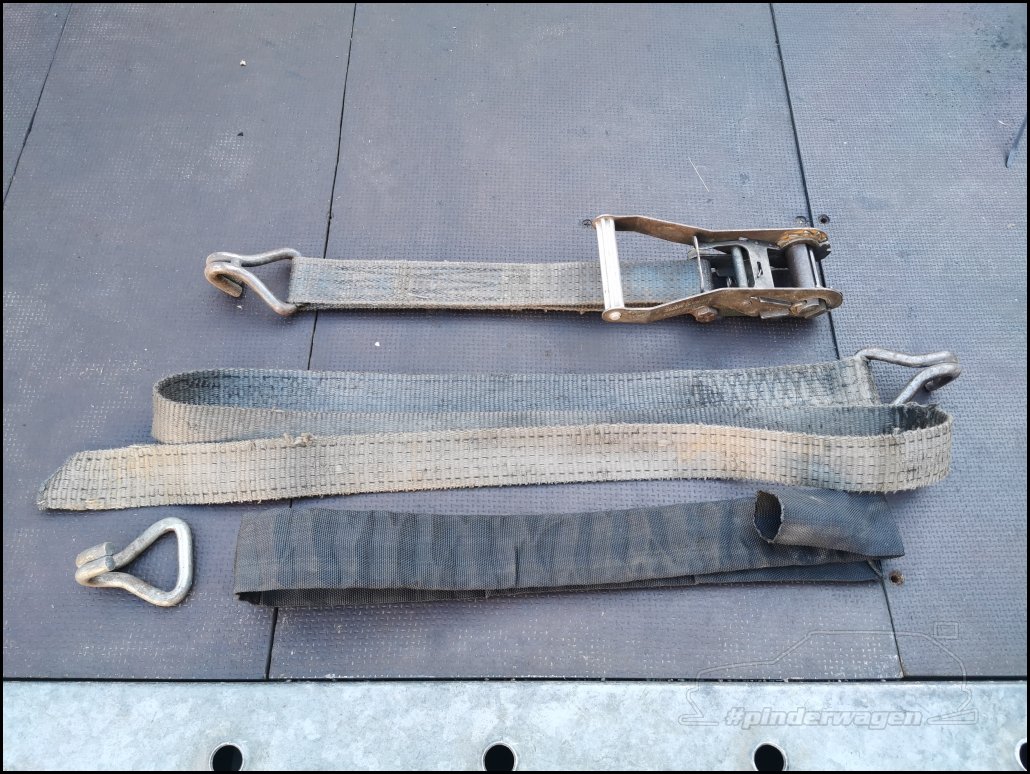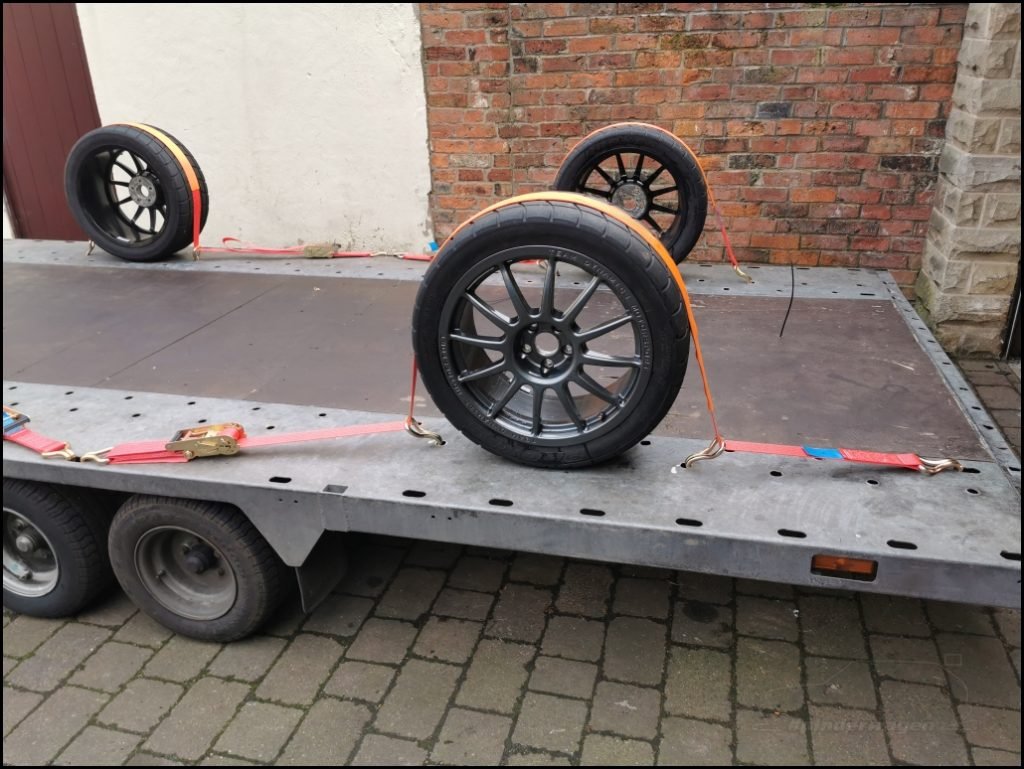The question of how to strap your car onto a trailer is something that gets asked pretty regularly so I`ve put together a short post showing what I believe is the best way to do it. The ‘over tyre’ method.
Since posting this, I’ve bought a new set of straps and cranked hooks from Martyn at www.strapmaster.co.uk he pointed out my old straps didn’t have the tags on them, they tore off years ago and they had nicks in them. It’s easy to miss gradual changes like that and could cause issues if stopped by VOSA.
The new straps and ratchets are all fully compliant.
You`ll see some photos with the old straps I had and a few new ones with the orange straps with cranked hooks from Martyn, just incase you wondered why there were blue and orange straps in the photos. 



Old straps

The most common way people strap their cars down is usually with a strap and loop such as these from PRG trailers.
I used to strap my car down the same way, but after once catching a brake line with the strap round the back of the wheel I started asking around and it was pointed out all the professional haulage people use the over tyre method.

They tend to do 2 straps per car, one at the front and another on the opposite corner on the rear. I use a strap on every wheel just be to be absolutely sure it’s secure.

I’ll take more photos of the straps fastened to the trailer when I’m able in a few weeks. In the meantime, here are the new straps, ratchets and hooks. Specifically designed to be installed in exactly this application.

I`ll explain how to strap the car using this method, what you need to do so and how to modify your trailer if necessary.
Parts required.
4 x 3m x 50mm Ratchet straps
4 x 50mm Claw Hook
4 x 1m x 50mm Sleeve


Why fit a sleeve ? On a road car you don`t need to but on a track car I`ve found it essential.
After a day on circuit the tyres are hot and sticky, so sticky that the strap isn’t able to be pulled tight over the tyre. I’ve pulled the ratchet as hard as I can, the strap going towards the wheel is bow tight but the other side is still flopping around. The friction from the sticky tread won’t allow the strap to slide across it.

Strap isn’t tight on opposite side of the tyre (exaggerated to show what actually happens)

I use 1m lengths of sleeving, whilst fiddly to fit, I find it works well. Initially I bought 3x300mm lengths per tyre from ebay but found they spread out, allowing the strap to still contact the tyre and not allow equal tightening.
To fit the sleeve onto the strap, you can try and push it through and get really frustrated or use something to pull it through.
I use a length of threaded bar, gaffer tape the end of the strap to the threaded bar

The strap ‘rolled’ to reduce the width

Push the threaded bar through the sleeve

Once through the other end, pull on the bar

The sleeve will bunch up

With some assistance, the strap will go through the whole sleeve

I’ve found the straighted the sleeve, hook the strap onto the trailer, hold the other end tight and simply slide the strap to the end

You now have a strap with sleeve fitted.

Securing the hook to the trailer.
There are 3 options next. You either have holes in the trailer bed already that are suitable. There are holes that are too small or you need to make some holes.
If the hooks fit, you don`t need to do anything.
If the holes are already in the trailer bed but are too small, the hook won’t fit.

I used a carbide end in an electric die grinder to quickly increase the size of the hole, obviously they have lots of other uses but for something like this they are ideal.
You can also use a step drill or a carbide end in a drill if you don`t have a die grinder but that takes longer and needs plenty of cutting fluid.

Squaring the corners takes a few moments

The hook then easily fits

If you don`t have any holes in the bed at all, it’s pretty easy to drill a couple of holes per wheel.
My trailer has holes, but imagine this piece of plate is actually the trailer bed 

Mark a line vertically from the side of the tyre


Same for the centre of the tyre width


Pilot drill. Check there are no cables underneath where you are drilling

Then use either a holesaw or step drill to cut a 26mm hole in the bed.

I used a step drill and plenty of cutting fluid with a low drill speed so as not to burn the cutting edge.

This is a 25mm Holesaw, but 26mm would be better.

One 26mm hole later.

Wipe the cutting fluid and check the hook fits easily.

The hook end of the strap goes to the rear of the wheel.



If you use your trailer regularly, you will usually see a mark on the bed where the tyre sits. I used this to fit the straps in the right place with the car off the trailer but if not, just mark the bed with the car in place then reverse it off to make the holes.

The hook can face forwards or backwards. I just pick the direction that gives the best angle of strap over the tyre


If I used the hole too far forwards, the angle would catch on the side skirts

The strap is vertical if the hook is closer to the wheel but it isn’t critical

The new hooks are bent before being zinc coated. They sit better for this type of use

The underside of the hook sits flush against the trailer bed


You`ll sometimes see straps in this layout, with an hook either side of the wheel. So long as the hook sits in the trailer bed properly and not at a weird angle, there is no need to do it this way.

So you`ve gone to all this effort of cutting holes in the trailer bed, but what’s the benefit ?
There is no chance of damaging the rim, the strap doesn’t rub against it whilst you are driving. The strap doesn’t pull the wheel sideways, the load is all on the tyre pulling it downwards. You can’t catch a cable or hose when fitting the loop behind the wheel. You often see the straps that are fitted around the tyre deform the sidewall quite badly, anything putting that sort of deformation into the sidewall for several hours or even days after an event isn’t good for the long term integrity of the tyre.
Once of the biggest benefits for me is the ease of fitting.
The straps are never fully removed, they are simply folded out of the way.

Drive the car into place

Lift the loop over the tyre and ratchet it down. It only takes seconds per corner.
You`ll notice the ratchet is secured towards the edge of the trailer. There are 2 reasons, 1 is that if they were in a straight line from the hook they’d be under the side skirt and on my car access is tight.
The main reason is that they are easy to access, I can loosen/tighten them quickly and they stay in place when reversing off or driving onto the trailer which speeds up unloading/loading.
“That’s not going anywhere!” 


After discussing this method with several friends, they have all switched to the over tyre method. They did struggle to source the sleeves, but I was able to get them from a local supplier for £15 delivered for 4 x 1m 55mm sleeves, if you are finding it difficult to get some, drop me a line and I can source them for you.
Somewhat surprisingly I`ve had a few messages from people asking if they can support me in some way. I`ve set up a buy-me-a-coffee page for those of you who would like to do so, it allows the opportunity of making a small donation towards future Golf development  .
.![]()



